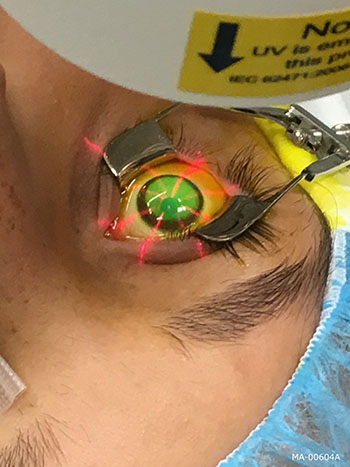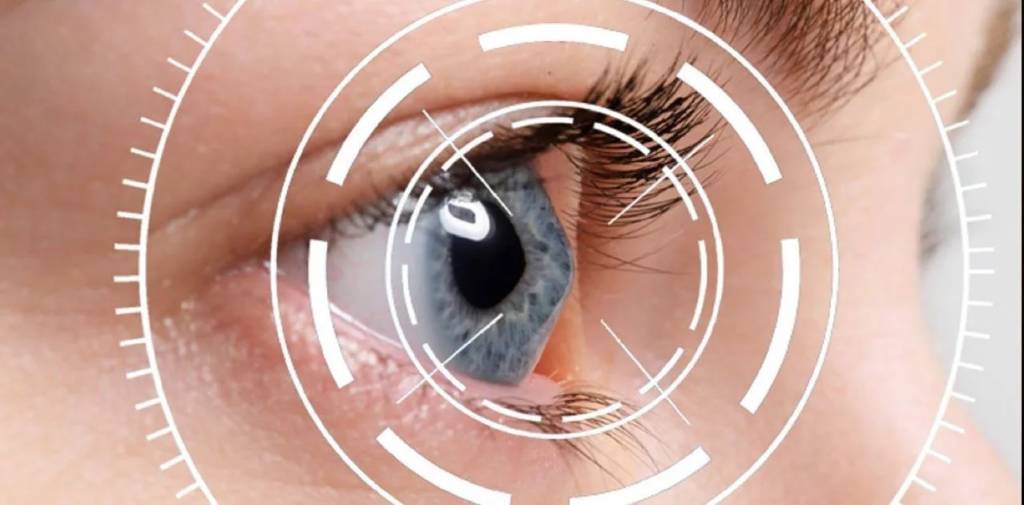Keratoconus is a noninflammatory, usually bilateral disorder, which manifests as progressive corneal instability characterized by abnormal thinning and steepening of the cornea.
This abnormal curvature of the cornea changes its refractive power, often resulting in irregular astigmatism and myopia and leading to mild to marked impairment in the quality of vision. Corneal Cross-Linking is a procedure used to strengthen corneas.
This is achieved by irradiating its substance with a laser beam (wavelength 375 nm), which leads to the formation of new chemical bonds between collagen fibers and gives greater mechanical strength to the stroma. A feature of this manipulation is stability, which lasts at least 3 years.

The physioenzymatic effect on the corneal tissue allows not only to increase visual acuity in patients who suffer from keratoconus, the treatment also eliminates the need for keratoplasty surgery.
Diagnosis of Keratoconus:
Keratoconus is an abnormal protrusion, or ectasia, of the corneal tissue. The causes and pathogenesis of this disease are not well understood. However, the incidence of keratoconus is gradually increasing. Incidence rates in different countries differ significantly, which is associated with different informativeness of the methods used for diagnosing keratoconus.
According to the World Health Organization, the incidence of keratoconus in the population is at least 8%, while there is an increasing frequency of registration of new cases of the disease.

This is supposed to be related:
• with the improvement of measures for diagnosing keratoconus,
• with carrying out refractive excimer operations with technical errors.
The pathogenesis of keratoconus is associated with a violation of the structure of the ground substance, or stroma, of the cornea.
There is a change in its optical-mechanical properties:
• loss of strength characteristics of collagen fibers,
• protrusion of the cornea under the influence of intraocular pressure.
Its protrusion can occur in two zones:
• central,
• paracentral.
Where ectasia forms, the cornea becomes thinner. Its thickness in the thinnest areas can be less than 500 microns. The result of the formation of keratoconus can be astigmatism. This condition is characterized by a decrease in vision that cannot be completely corrected with glasses or contact lenses.
The described changes are typical for stages I and II of keratoconus. The progression of the disease (stage III) is characterized by the formation of a thorn on the cornea. There is a significant decrease in visual acuity. Possible rupture of its tissues with the outflow of intraocular fluid and complete anatomical death of the structures of the eye.
Cross-Linking Method:
The use of the cross-linking method is based on the stimulation of the formation of new chemical bonds between collagen molecules in the corneal stroma. This operation allows you to achieve a stable and sustainable result, which lasts at least 3 years. In the future, it is possible to repeat the procedure.
The Operation Includes 2 Stages:
• Removal of the epithelial layer from the surface of the cornea. After it is done, the drug can penetrate into its stroma and realize its effect there.
• This stage occurs without the participation of an ophthalmologist. The nurse instills a special composition into the patient’s eye.
Next, the effect of laser radiation is carried out, which, together with the drug, stimulates the strengthening of the corneal tissues.

As a result of a decrease in astigmatism, patients note an increase in visual acuity. The procedure takes about one and a half hours. At the end of the manipulation, the patient is recommended to wear a contact lens for 3 days, as well as regular instillation of eye drops for 10-15 days.
After Cross-Linking, it is recommended to undergo regular examinations with an ophthalmologist (once every six months). It should be emphasized that the use of this method improves visual acuity in patients with keratoconus and thinned cornea. To fully restore refraction and achieve optimal visual acuity, the cross-linking technique can be supplemented with laser keratectomy (LASIK).
Benefits of choosing AstraMedicaGroup
Only top qualified doctors
JCI certificated hospitals
Free COVID-19 Test before departure
4 nights in a 5-star hotel in Istanbul
Costs for laboratory, medication and equipment
Pre/post-operative tests
Free Istanbul tours
Latest technologies
Excelent travel assistance
All-round VIP transfer
Credit / Debit cards accepted
No prepayment
Personal assistants speak in English
24/7 customer service
